“COMRADES IN ARMS” – By Des Kelly
There are dozens of stories about them, various animals and even birds like pigeons who have been these loyal “Comrades-in-Arms”, giving invaluable aid to their Masters & Mistresses, both in Peacetime & War.
Going back, into history, horses come to mind. Hundreds of then fighting together with their masters riding them, in battles lasting for hours, dying with them, if beaten, loyal o the very end. Little trained pigeons, carrying messages for their carers, for kilometres, and sometimes being shot, for their trouble, and of course, Man’s best friends, dogs, of all shapes and sizes, doing what was necessary to protect their human mates, even to the death, if need be.
These, then, are some of the Comrades-in Arms that
this story is about. Read it carefully my friends, and even if you are not an animal lover like me, you will begin to realize how these animals and birds could well be classified as War heroes, loving, loyal Comrades ever prepared to even give their lives for their human counterparts.

Desmond Kelly
(Editor-in-Chief) eLanka.
The Stories of These Great Animal War Heroes Is Inspiring: Edited By: Bhavesh Bhimani
Source: Babamail
Heroes of wars come in all kinds of shapes and sizes. Sometimes, though, they also come in different forms of species. Throughout history, we have learned how animals have been used in conflicts. Horses, pigeons, dogs, and even pigs have served in different units both in the First and Second World Wars, displaying outstanding valor in times of need. They have tracked enemies, protected troops and even helped turn battles around with their gallantry.
Here, we look at the stories of some truly brave animal war heroes that left their indelible mark in the two World Wars.
1. Wojtek the Bear
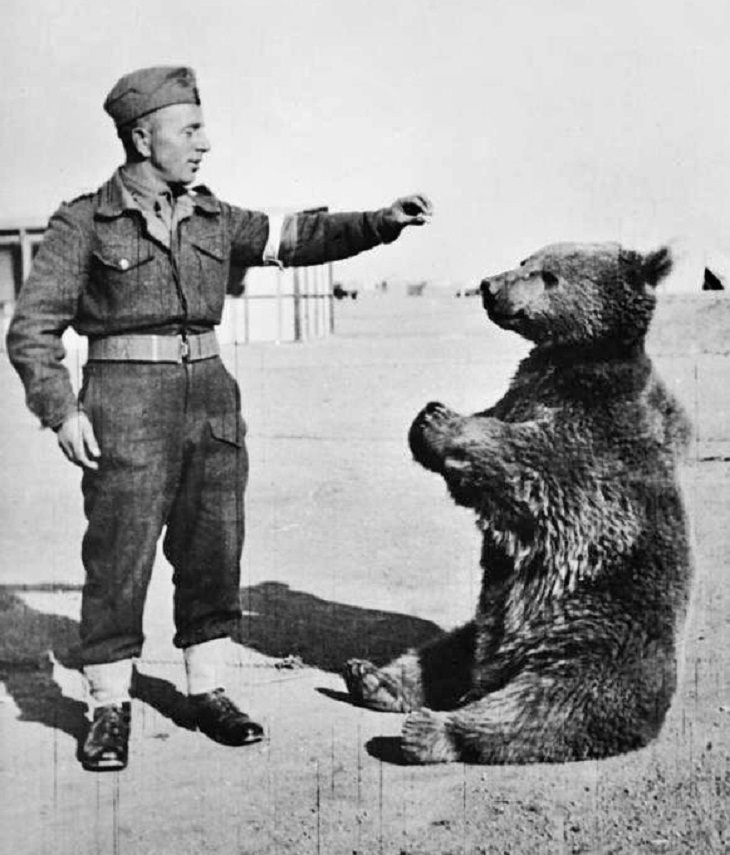
Image source – Wikimedia Commons
Wojtek, popularly known as the ‘Soldier Bear’, was a lovable and loyal pet mascot of the 22nd Transport Artillery Supply Company, Polish II Corps, during the Second World War. He was a Persian bear cub who was adopted by a unit of Polish soldiers while they were training under the British Army in the Middle East.
The bear was raised to be a good soldier and he did his job well. Wojtek, meaning ‘little one’, weighed around 113 kg (250 lbs) and was over six feet tall (1.83 m). When the unit was sent to Europe, they had to make Wojtek an official soldier to take him along with them. Thus, he soon came to be known as Corporal Wojtek of the artillery supply unit. He was known to be a friendly animal and even indulged in wrestling or play-fighting with the men.
The biggest highlight of Wojtek’s career was during the Battle of Monte Cassino when the mighty bear helped to load 100-pound boxes of artillery shells into trucks every single day until the battle was won. To honor his service, the army put an image of the bear carrying ammo on the unit’s official badge.
When the war was over, Wojtek traveled to Scotland with his unit and he eventually found a stable home in the Edinburgh Zoo where he stayed until his death in 1963.
2. Tirpitz the Pig
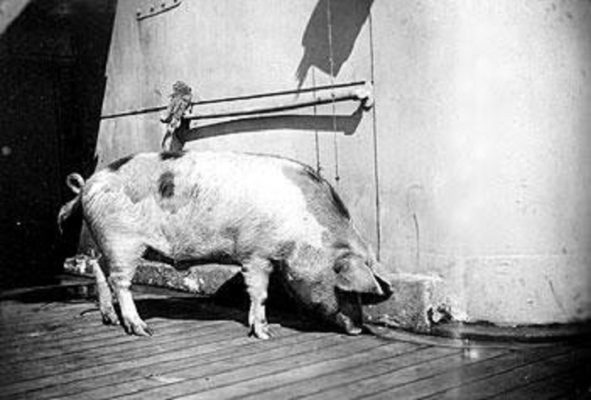
Image source – Wikimedia Commons
He was perhaps the most famous real-life pig of his time, and we can’t help but wonder why films have not been made on his story. Tirpitz was a pig who was the mascot of HMS Glasgow during the First World War.
Interestingly, Tirpitz was initially carried aboard the German warship SMS Dresden in 1914. Unfortunately, the ship sank a year later and the pig was abandoned with it. However, Tirpitz managed to survive by swimming away and escaping from the sinking vessel. The HMS Glasgow crew spotted the scared animal and rescued him. Later, Tirpitz was awarded the Iron Cross for bravery and he was adopted as the unit’s mascot. The pig remained with the crew for two years and served them well.
In 1916, Tirpitz was transferred to the Whale Island Gunnery School in Portsmouth. Three years later, the pig was auctioned off for pork and even in his final act, he managed to raise £1785 for the British Red Cross. Tirpitz’s head still remains on display at the Imperial War Museum in London.
3. Sergeant Reckless, the War Horse
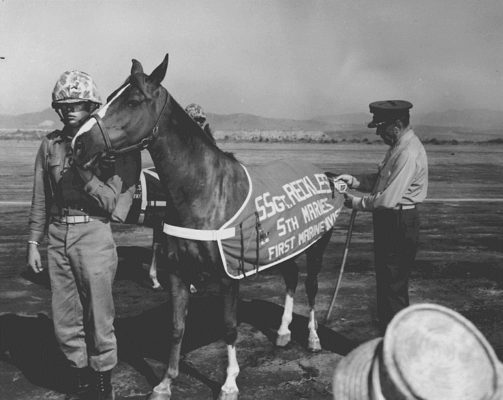
Image source – Wikimedia Commons
“Horses are flight animals, but Reckless ran toward the danger because she knew the guys needed her,” says Robin Hutton, author of ‘Sgt. Reckless: America’s War Horse’. The animal being talked about here was a horse named Ah Chim Hai (Flame in the Morning) who was sold by a young Korean to the U.S. Marines in 1952. The mare was renamed Reckless by the Marines and she went on to forge a great rapport with the troops in the following years. The horse became renowned for its voracious appetite and loved to gorge on candy, beer, eggs, and coffee.
Reckless was primarily used to carry ammunition. She was great at her job and during the five-day Battle of Outpost Vega in March of 1953, she displayed incredible fortitude after making 51 trips to the front in just one day to transport ammunition and carry wounded Marines out. Impressively, most of these trips were unaccompanied. In total, Reckless carried 9,000 pounds (4.082 kg) of ammunition that day and walked for over 35 miles (56 km) even as the enemy kept firing all around her and even while she was wounded.
This act of bravery earned Reckless a promotion to Staff Sergeant and she also received two Purple Hearts and many other medals later. Once the war was over, Reckless was taken to San Francisco on November 10, 1954, where she was honored at the Marine Corps Birthday Ball. Reckless lived her remaining years happily at Camp Pendleton and passed away in 1968.
4. Winkie the Pigeon
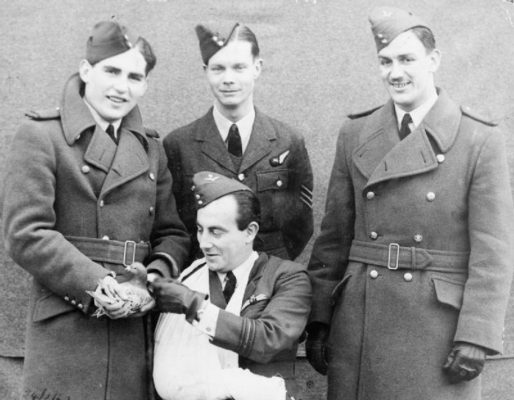
Image source – Wikimedia Commons
Carrier pigeons were famously used during the two World Wars and played an important role as military messengers. In fact, at the beginning of World War II, about 2,000 English pigeons were deployed for use. Also called homing pigeons, they were used by British, American, Canadian, and German troops in different parts of the world during the war. These birds would carry the messages in special containers that would be tied to their legs and in small pouches on their backs.
On February 23, 1942, a particular carrier pigeon made history because of his bravery. On that eventful day, the crew of the British Bristol Beaufighter was returning from a mission over Norway. However, they were badly hit by enemy fire and crashed into the sea while they were still more than 100 miles (160 km) from home. The men couldn’t use the radio in the icy waters and had to rely on the carrier pigeon, Winkie, to deliver the message of their plight to the airbase.
The pigeon rose to their help by flying over 120 miles (193 km) and was finally discovered covered in oil and completely worn out by its owner George Ross. While Winkie wasn’t carrying a message with her, the Royal Air Force was able to deduce the position where the aircraft had fallen. A rescue mission was promptly launched and the men were found and saved within 15 minutes. The pigeon was hailed as a hero by the members of the airbase who lauded her unflinching devotion.
For her unreal show of courage under exceptionally difficult conditions, Winkie received the Dickin Medal – the first animal ever to get the award. More than 70 animals have since received this prestigious award, which was initiated to honor the work of animals in the war.
5. Rip the Stray Dog
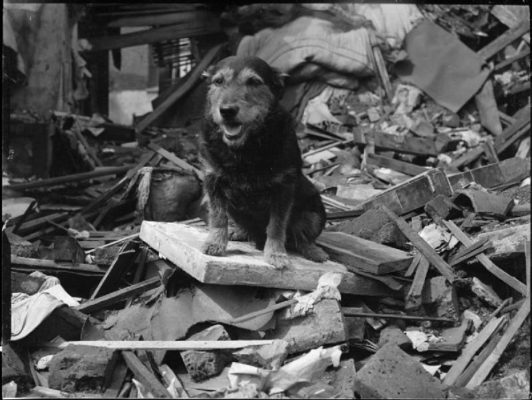
Image source – Wikimedia Commons
Rip was a stray dog who had been adopted by an air raid warden in east London during the Second World War. He was a wiry-haired dog and was known to be friendly with all the members of the Poplar ARP (Air Raid Precautions) he interacted with.
It was during the Blitz when the Germans had launched a bombing campaign against the United Kingdom in 1940 and 1941 when Rip showed his true worth. As the search and rescue work was going on after the air raid, the dog managed to search and eventually save more than 100 survivors who were trapped below the rubble and wreckages of buildings.
The gallantry of the dog didn’t go unnoticed and Rip was honored with the distinguished Dickin Medal.
6. Wing Commander Bill the Goat
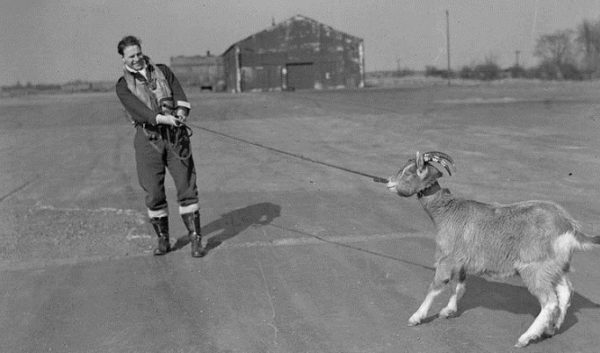
Image source – Wikimedia Commons
A goat named Bill was quietly pulling a cart in a small town in Saskatchewan when he was noticed by Canadian soldiers in a train that was off to serve in the First World War. The soldiers were impressed by the goat and requested its owner, a little girl, to allow them to take him with them as a good luck charm. The girl agreed and Bill became part of the unit.
Throughout the war, Bill stayed with the unit and endured several wounds by shrapnel. However, he was also a naughty animal and was once caught eating military equipment. Despite that, however, Bill was more than a handful in the war as he saved at least three lives by head-butting the men into a trench merely seconds before shells exploded near them.
Bill survived the war, despite all the injuries he faced and was even part of a big parade in Germany. He was presented with the 1914 Star, the General Service Medal, and the Victory Medal for his exemplary service in the war. The goat was later taken back to his hometown in Saskatchewan where he reunited with his owner and led his retired life peacefully. When Bill died, he was stuffed, mounted, and placed in the Saskatchewan Legislative Building and later became a part of the Broadview Museum in Canada.
7. Sergeant Stubby
Known as America’s most decorated war dog, Sergeant Stubby had served as the mascot of America’s 102nd Infantry Regiment during the First World War. A dog of an uncertain breed, Stubby has generally been described as a Bull Terrier or Boston Terrier. He was found in Connecticut in 1917 when he wandered into the encampment and was adopted by the members of the infantry.
A young soldier called Robert Conroy smuggled the dog onto a ship heading to France and Stubby eventually went on to participate in four offensives and 17 battles. During the First World War, Stubby kept a careful watch and alerted the troops to German attacks. In the course of his service, the dog was injured and wounded several times, but he continued unabated. He saved a US infantryman from a gas attack and once even caught a German spy, latching on to his breeches until help arrived.
After the end of the war, Stubby returned to America as a hero and was honored with a medal for heroism from the Humane Education Society. In the following years, he received several more awards and was even given the unofficial rank of sergeant. To display his awards prominently, some women made the dog a chamois blanket with Allied flags that Stubby wore proudly for many years.


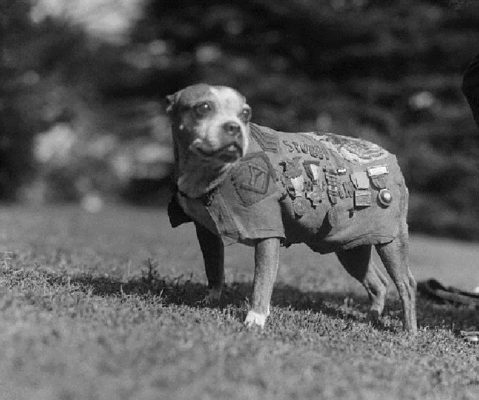






No Comments